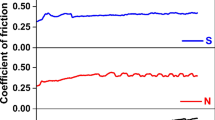Abstract
Unlike aliphatic polyamides, the friction coefficient of polyaramides depends not only on the relative concentration of hydrogen bonds in a macromolecule unit, but also on the structural factor, which is related to various positions of the hydrogen bonds in a phenylene nucleus, in this case, the para- and metapositions. During dry friction, aramide organoplastics are characterized by a high coefficient of friction, while for materials based on polyoxadiazole fibers, a low and stable coefficient of friction is retained.
Similar content being viewed by others
References
Aderikha, V.N., Dovgyalo, V.A., Pleskachevskii, Yu.M., and Konopleva, I.I., Effect of radiation-chemical functionalization of polyethylene on structure and the triboengineering behavior of polymeric polyamide-polyethylene blends, J. Frict. Wear, 2000, vol. 21, no. 2, pp. 48–53.
Jassal, M. and Ghosh, S., Aramid fibres - an overview, Indian J. Fibre Textile Res., 2002, vol. 27, no. 3, pp. 290–306.
Chatzi, E.G. and Koenig, J.L., Morphology and structure of kevlar fibers: A review, Polymer-Plastics Technol. Eng., 1987, nos. 3–4, pp. 229–270.
Kakida, H., Chatani, Y., and Tadokoro, H., Crystal structure of poly(m-phenylene isophthalamide), J. Polymer Sci.: Polymer Phys. Ed., 1976, vol. 14, no. 3, pp. 427–435.
Tashiro, K., Nimmanpipug, P., and Rangsiman, O., Factors governing the 3-dimensional hydrogen-bond network structure of poly(m-phenylene isophthalamide) and a series of its model compounds (2) computer simulation of crystal structures of aromatic amide compounds and comparison with X-ray analyzed structures, J. Phys. Chem. B, 2002, vol. 106, pp. 12884–12895.
Huang, T., Lu, R., Ma, Y., Liu, P., and Li, T., Study on the friction and sliding wear behavior of hybrid polytetrafluoroethylene /kevlar fabric composites filled with polyphenylene sulfide, J. Macromol. Sci. Part B-Phys., 2012, vol. 51, no. 1, pp. 109–124.
Korshak, V.V., Gribova, I.A., Krasnov, A.P., Mamatsashvili, G.V., Dzhashiashvili, T.I., and Lioznov, B.S., Thermofriction properties of reinforced systems on the basis of material from polyheteroarilens, Trenie Iznos, 1984, vo. 5, no. 6, pp. 265–271.
Yudin, A.S., Buyaev, D.I., Afonicheva, O.V., Goryacheva, I.G., and Krasnov, A.P., Friction of selflubricating polymer composites reinforced by heatresistant fabrics, J. Frict. Wear, 2013, vol. 34, no. 4, pp. 245–252.
Askadskii, A.A., Matseevich, T.A., Popova, M.P., and Kondrashchenko, V.I., Prediction of the compatibility of polymers of the microphase compositions and some properties of blends, Polymer Sci., Ser. A, 2015, vol. 57, no. 2, pp. 186–199.
Mikhailin, Yu.A., Konstruktsionnye polimernye kompozitsionnye materialy (Structural Polymer Composite Materials), St. Petersburg: NOT, 2013, 2nd ed.
Author information
Authors and Affiliations
Corresponding author
Additional information
Original Russian Text © D.I. Buyaev, A.P. Krasnov, A.V. Naumkin, A.S. Yudin, O.V. Afonicheva, A.S. Golub, M.V. Goroshkov, M.I. Buzin, 2016, published in Trenie i Iznos, 2016, Vol. 37, No. 4, pp. 452–459.
About this article
Cite this article
Buyaev, D.I., Krasnov, A.P., Naumkin, A.V. et al. Effect of chemical structure of aramide and polyoxadiazole fibers on friction of organoplastics. J. Frict. Wear 37, 351–357 (2016). https://doi.org/10.3103/S106836661604005X
Received:
Published:
Issue Date:
DOI: https://doi.org/10.3103/S106836661604005X




